

History of Ladyland Farm
Circa 1560:
History
The existing four-bay timber-framed Tudor yeoman's farmhouse of Ladyland Farm was built in the early years of the sixteenth century, at the time of the dissolution of the monasteries by Henry VIII.
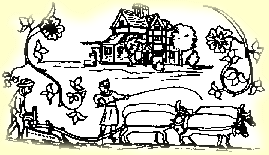 But people must have lived and worked at Ladyland hundreds of years before this farmhouse was built, because records show that in medieval times King Alfred's grandson, Athelstane, granted Ladyland Manor to the Abbot of Cherstsey.
In the Thirteenth Century the Farm was let to Fulk de Archek, who paid a few pence a year as rent for the farmhouse and 40 acres of land.
But people must have lived and worked at Ladyland hundreds of years before this farmhouse was built, because records show that in medieval times King Alfred's grandson, Athelstane, granted Ladyland Manor to the Abbot of Cherstsey.
In the Thirteenth Century the Farm was let to Fulk de Archek, who paid a few pence a year as rent for the farmhouse and 40 acres of land.
At the time that Chertsey Abbey was destroyed, Ladyland Manor was given by Henry VIII to Nocholas Carew, who was then living in Beddington. 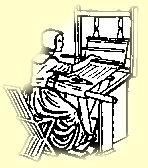 Nicholas, being in need for money, sold the Manor of Horley to Henry Lechford, who, in turn, rented it to Richard Hever for £12 a year.
The Court Rolls for Ladyland list occupants of the farm from 1569. In 1676 the Farm was bequeathed by Richard Gorbett to the worshipful Company of Cooks, and was owned by them until 1972.
Nicholas, being in need for money, sold the Manor of Horley to Henry Lechford, who, in turn, rented it to Richard Hever for £12 a year.
The Court Rolls for Ladyland list occupants of the farm from 1569. In 1676 the Farm was bequeathed by Richard Gorbett to the worshipful Company of Cooks, and was owned by them until 1972.
The building
The farmhouse is built of wattle and daub infilling the oak timber frame. Wattle and daub was replaced in 1820 with bricks.
 Bricks were imported into the country as ballast in returning merchant ships that had been used to transport wool.
Bricks were imported into the country as ballast in returning merchant ships that had been used to transport wool.
Legend has it that a secret cupboard in the farmhouse was used as a priest's hole, leading to a tunnel, the entrance to which is situated nearby on Meath Green Road. Who knows which persecuted priest may have made his escape through the tunnel?
Living in Ladyland Farm in Tudor times
The farm would have been largely self-supporting.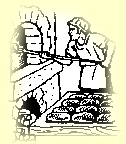 The Hall, used by the farmer and all the farm workers for eating meals cooked in open hearth, on a large spit-rack, must have been a busy, smoky place. The central chimney would have served to heat the whole house.
A separate parlour was used by the family.
About fifty years after the farmhouse was built a large baker's oven was added. The area was well wooded providing a plentiful supply of fuel.
Water was obtained from the well situated just outside the house.
The Hall, used by the farmer and all the farm workers for eating meals cooked in open hearth, on a large spit-rack, must have been a busy, smoky place. The central chimney would have served to heat the whole house.
A separate parlour was used by the family.
About fifty years after the farmhouse was built a large baker's oven was added. The area was well wooded providing a plentiful supply of fuel.
Water was obtained from the well situated just outside the house.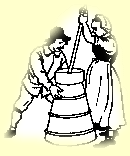 Milk from the dairy herd was stored in the cool, sunken dairy where it was made into butter and cheese.
As today, sheep, cattle, pigs, rabbits, pigeons, horses, hens, ducks and geese would have been kept on the farm and cereals, fruit and vegetables grown, providing a varied diet, clothing and transport.
Milk from the dairy herd was stored in the cool, sunken dairy where it was made into butter and cheese.
As today, sheep, cattle, pigs, rabbits, pigeons, horses, hens, ducks and geese would have been kept on the farm and cereals, fruit and vegetables grown, providing a varied diet, clothing and transport.
Families Living at Ladyland
 Ladyland farm must have provided an excellent place in which to live. Records show farmers living to the ripe old age of 82 years, at a time when the average life expectancy was 48 years.
Families with ten to twelve children are recorded in the Parish Records with relatively few infant deaths noted at a time when these were regarded as inevitable.
Ladyland farm must have provided an excellent place in which to live. Records show farmers living to the ripe old age of 82 years, at a time when the average life expectancy was 48 years.
Families with ten to twelve children are recorded in the Parish Records with relatively few infant deaths noted at a time when these were regarded as inevitable.
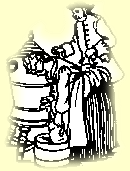 The 1841 Census shows the Best Family living at the farm, comprising John and his five children (presumably his wife had died, probably at childbirth), together with four farm workers and a female servant.
The 1841 Census shows the Best Family living at the farm, comprising John and his five children (presumably his wife had died, probably at childbirth), together with four farm workers and a female servant.
Woodlands
Up until the early years of the Nineteenth Century, the woodlands of the Meath Green area were not only used locally to provide fuel, fencing and building materials, but large amounts of timber were sent to Croydon for making into charcoal.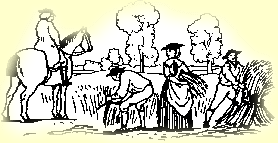 This was used in the iron smelting industry, so Ladyland, as well as being a farm, made its own contribution to the industrial Revolution.
This was used in the iron smelting industry, so Ladyland, as well as being a farm, made its own contribution to the industrial Revolution.
In 1760 there is an account showing the sale of timber from Ladyland Farm for £650. Remembering that a family could live on a few pence a week, that was an enormous amount of money.







